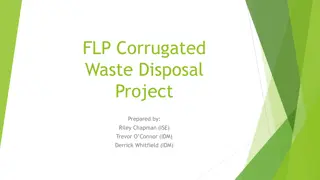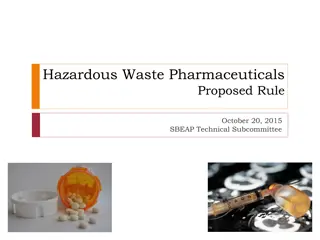Proper Handling and Disposal of Hazardous Drugs and Waste
Guidelines for the safe handling and disposal of hazardous drugs and waste in healthcare facilities. The content covers training modules, waste collection, sources of healthcare waste, disposal methods, and legal regulations related to the disposal of hazardous drugs. Various types of healthcare waste, including cytotoxic waste, are discussed along with their sources and appropriate disposal methods.
Download Presentation

Please find below an Image/Link to download the presentation.
The content on the website is provided AS IS for your information and personal use only. It may not be sold, licensed, or shared on other websites without obtaining consent from the author.If you encounter any issues during the download, it is possible that the publisher has removed the file from their server.
You are allowed to download the files provided on this website for personal or commercial use, subject to the condition that they are used lawfully. All files are the property of their respective owners.
The content on the website is provided AS IS for your information and personal use only. It may not be sold, licensed, or shared on other websites without obtaining consent from the author.
E N D
Presentation Transcript
Waste Collection + Disposal DATE PLACE Disclaimer: This presentation contains information on the general principles for safe handling of hazardous drugs. This presentation cannot account for individual variation among facilities and cannot be considered inclusive of all proper methods of occupational safety. It is the responsibility of the facility management and staff to determine the best course of occupational safety for operations. The American Cancer Society and its partners assume no responsibility for any injury or damage to persons or property arising out of or related to any use of these materials, or for any errors or omissions. Last updated: February 2020
Staff who handle hazardous drugs (HDs) and HD waste Who should take this training? These staff may include physicians, technicians, nurses, pharmacists, and cleaners 2
Training Modules + Learning Objectives Categories of Healthcare Waste List categories of healthcare waste Sources of Waste List sources of cytotoxic waste Collection of Waste Describe appropriate collection, transportation, and storage of HD waste Identify waste disposal methods and types of incineration Disposal of Waste 3
The disposal of HDs and cytotoxic waste is governed by local laws and regulations. Reference: 1 4
Sharps Infectious waste Pathological waste Healthcare waste includes: Pharmaceutical waste Hazardous chemical waste Radioactive waste Non-hazardous general waste Reference: 2
Cytotoxic wastes are generated from several sources and can include the following:
1. Contaminated materials from drug preparation and administration, such as: syringes needles gauzes packaging 2. Outdated drugs, excess (leftover) solutions, and drugs returned from the wards. Reference: 3 7 This Photo by Unknown Author is licensed under CC BY
3. Urine, feces, and vomit from patients 4. PPE worn when handling HDs 8 Reference: 4,5 This Photo by Unknown Author is licensed under CC BY-SA
Cytotoxic waste should be disposed in clearly marked bags or bins, indicating cytotoxic waste. 9 Reference: 3 Source Flickr. Photo by Ryan Ozawa
All cytotoxic contaminated waste must be clearly marked as cytotoxic and clearly identifiable to all staff who will be involved in handling this waste. 10 This Photo by Unknown Author is licensed under CC BY-SA This Photo by Unknown Author is licensed under CC BY-SA Reference: 3
Waste Bins Waste bins should be sealed prior to collection and should not be reopened or reprocessed on site 11 Reference: 3
Containers Collected by the cleaning personnel Sealed so that they are airtight Transported on wheel-driven carts Reference: 3
Transportation Carts Offer protection for the handling personnel Cleaned and disinfected easily Must not be used for any other kind of waste Reference: 3
All containers and wheel-driven vehicles must be marked with the same label. A second label on the containers may be used with the date of waste production. Labels Reference: 3 14
Waste Storage Easily identifiable Dedicated Secure Adequate lighting Away from drains Ventilation If waste is stored for more than 72 hours prior to disposal, consideration should be given to refrigerating the waste, particularly if waste is mostly organic and can decompose Reference: 3 15
Cytotoxic waste is highly hazardous and should never be landfilled or discharged into the sewerage system. Reference: 2 16 This Photo by Unknown Author is licensed under CC BY
Disposal options include: RETURN TO THE ORIGINAL SUPPLIER INCINERATION AT HIGH TEMPERATURES CHEMICAL DEGRADATION 17 Reference: 2
High temperature incineration is usually preferred over other methods. Full destruction of all cytotoxic substances may require incineration temperatures up to 1200 C 18 This Photo by Unknown Author is licensed under CC BY-SA Reference: 2
Destruction Methods High-temperature incineration Chemical degradation Exportation of cytotoxic wastes Encapsulation or inertization Last Resort Reference: 2 19
Not Not appropriate for cytotoxic waste destruction Single- chamber incinerators Municipal incinerators Open-air burning 20 Reference: 2
21 1. Pan American Health Organization. Safe handling of hazardous chemotherapy drugs in limited-resource settings [Internet]. 2013. 2. Chartier Y, Emanuel, Jorge, Pieper, Ute, Pruss, Annette, Rushbrook, Philip, Stringer, Ruth, et al., editors. Safe management of wastes from health-care activities [Internet]. 2nd ed. World Health Organization; [cited 2018 Apr 13]. 3. Connor T, McLauchlan R, Vandenbroucke J. ISOPP Standards of Practice: Safe Handling of Cytotoxics. J Oncol Pharm Pract. 2007;13(1). References 4. Polovich M, Olsen M, LeFebvre K. Chemotherapy and biotherapy guidelines and recommendations for practice. 4th ed. Oncology Nursing Society; 2014. 5. NIOSH Alert: preventing occupational exposures to antineoplastic and other hazardous drugs in health care settings. U.S. Department of Health and Human Services, Public Health Service, Centers for Disease Control and Prevention, National Institute for Occupational Safety and Health, DHHS (NIOSH) Publication No 2004 165; 2004.























